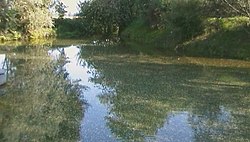Province of Cremona
| Province of Cremona | |
|---|---|
| Province | |

A view of a spring of water in Capralba
|
|
 Map highlighting the location of the province of Cremona in Italy |
|
| Country |
|
| Region | Lombardy |
| Capital(s) | Cremona |
| Comuni | 115 |
| Government | |
| • President | Carlo Vezzini |
| Area | |
| • Total | 1,771 km2 (684 sq mi) |
| Population (1 January 2015) | |
| • Total | 361,610 |
| • Density | 200/km2 (530/sq mi) |
| Time zone | CET (UTC+1) |
| • Summer (DST) | CEST (UTC+2) |
| Postal code | 26100, 26010-26049 |
| Telephone prefix | 0372, 0373, 0374, 0375, 0363 |
| Vehicle registration | CR |
| ISTAT | 019 |
The Province of Cremona (Italian: Provincia di Cremona) is a province in the Lombardy region of Italy. Its capital city is Cremona.
The province occupies the central section of Padana Plain, so the whole territory is flat, without any mountains or hills, crossed by several rivers, such as the Serio and Adda, and artificial canals, most of which are used for irrigation.
The river Po, which is the longest Italian river, is the natural boundary with the adjoining Province of Piacenza, while the Oglio separates the province from Brescia.
Lombardy has been inhabited since ancient times and stone age and Bronze Age rock drawings and artefacts have been found there. From the fifth century BC, Gallic tribes invaded and settled in the region, building several cities (including Milan) and ruling the land as far as the Adriatic Sea. From the third century BC the Romans expanded their sphere of influence into the area, and in 194 BC, the whole of what is now Lombardy, became a Roman province called Gallia Cisalpina. The Romans overwhelmed the previous civilisations and Lombardy became one of the richest and best-developed areas in Italy. It was here in 313 AD that the Roman Emperor Constantine the Great issued the famous Edict of Milan that gave freedom of religion to all people in the Roman Empire.
Following the collapse of the Western Roman Empire, Lombardy was invaded by successive waves of tribes, the last of which was the Germanic Lombards in the late sixth century. Stability followed until 774, when the Frankish king Charlemagne conquered the area and annexed the Kingdom of the Lombards (most of northern and central Italy) to his empire.
...
Wikipedia
